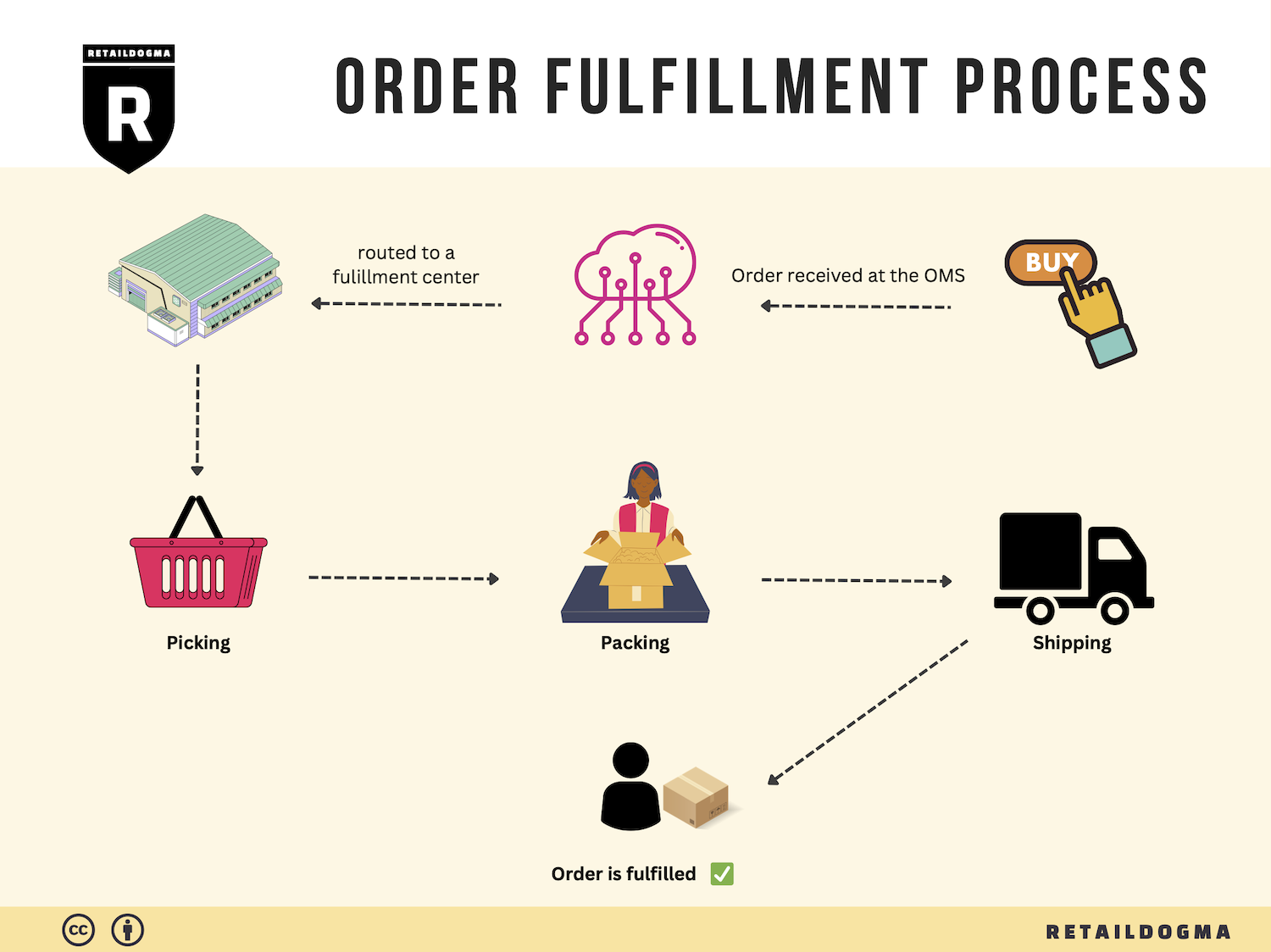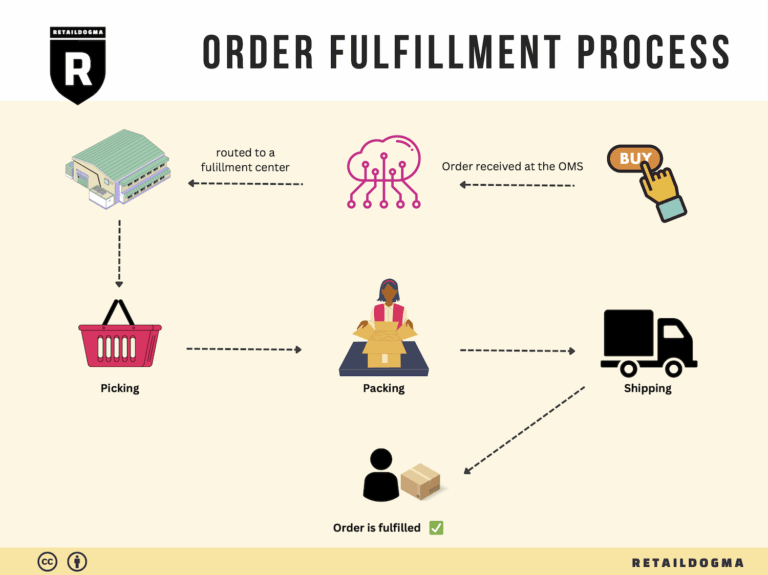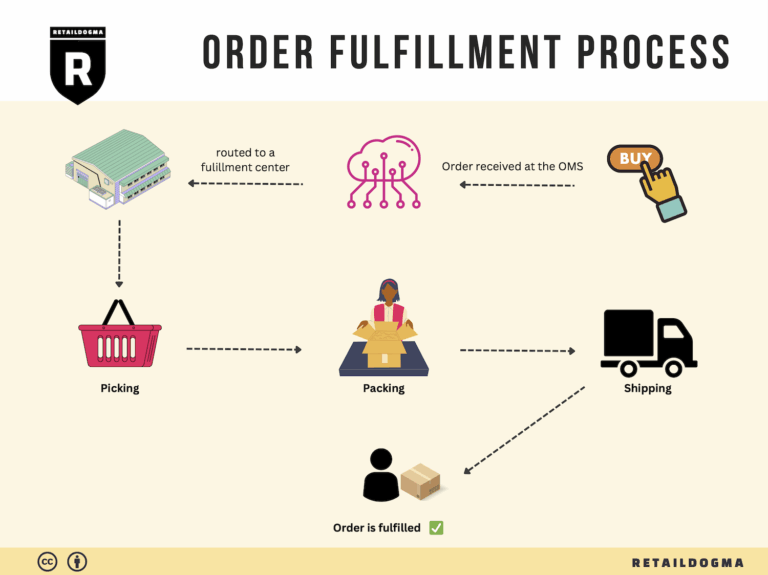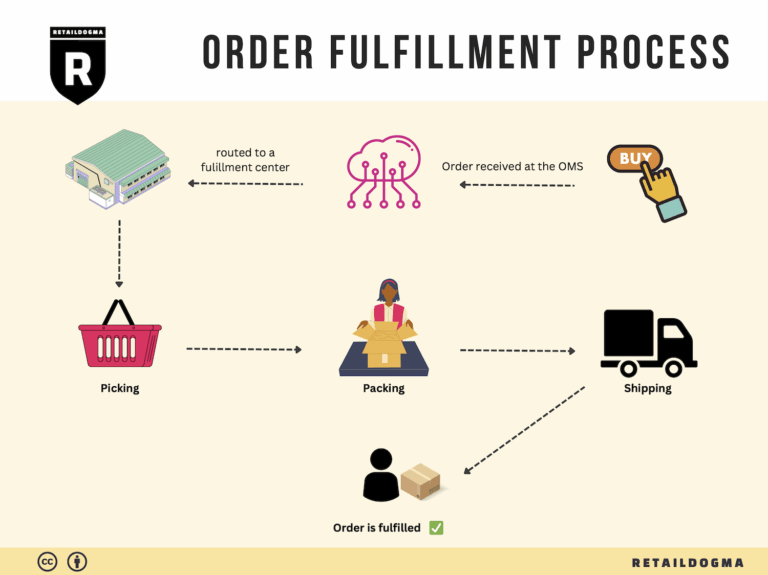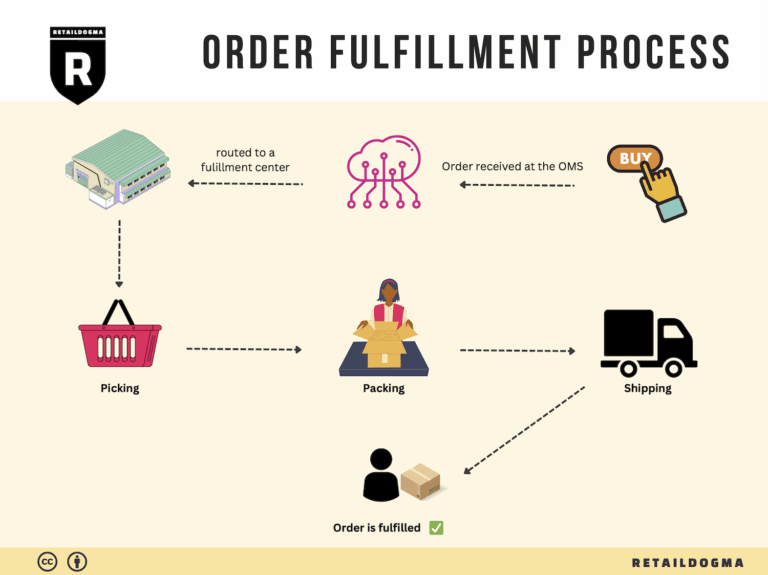Ecommerce Fulfillment Services: The Ultimate Guide (2025)
What is E-commerce Fulfillment? An Introduction for Growing Businesses
Understanding the Challenges of E-commerce Fulfillment
As an e-commerce business owner, the thrill of growing sales can quickly turn into a daunting challenge when it comes to packing and shipping orders. Many entrepreneurs find themselves overwhelmed by the sheer volume of orders, struggling to manage logistics effectively. This is where e-commerce fulfillment comes into play. Simply put, fulfillment is the comprehensive process of getting a product from your online store to your customer’s doorstep, encompassing everything from inventory management to shipping and returns.
What This Guide Will Cover
In this guide, we will delve into the various models of e-commerce fulfillment that can help alleviate the stress of logistics. We will explore options such as Third-Party Logistics (3PL) providers and Fulfillment by Amazon (FBA), each offering unique benefits tailored to different business needs. Understanding these models is crucial for selecting the right fulfillment strategy as you scale your operations.
Next, we’ll discuss the core services that fulfillment companies offer. This includes inventory storage, order picking and packing, shipping logistics, and returns management. Each of these components plays a vital role in ensuring that your customers receive their products quickly and in excellent condition.
Choosing the right fulfillment partner is another critical aspect that we will cover. With numerous providers available, knowing what to look for—such as accuracy rates, shipping speed, scalability, and customer service—is essential to ensure a seamless fulfillment experience.
Additionally, we will touch on pricing structures commonly associated with fulfillment services. Understanding how costs are calculated, including shipping fees, storage fees, and handling charges, will empower you to make informed decisions that align with your budget and growth projections.
Empowering Your Business Decisions
Ultimately, the goal of this guide is to equip e-commerce businesses with the knowledge and tools necessary to navigate the complex world of logistics confidently. By understanding e-commerce fulfillment better, you can make smart decisions that not only enhance your operational efficiency but also improve customer satisfaction and drive growth. Whether you are a startup or an established brand looking to optimize your fulfillment strategy, this guide will serve as a valuable resource on your journey to scaling your e-commerce business.
What You’ll Learn In This Guide
- What is E-commerce Fulfillment? An Introduction for Growing Businesses
- The Order Fulfillment Process: From ‘Buy’ Button to Customer’s Door
- Comparing Fulfillment Models: In-House vs. 3PL vs. Dropshipping
- A Deep Dive into Amazon FBA: Pros, Cons, and Who It’s For
- Core Services Offered by Fulfillment Centers
- How to Choose a Fulfillment Partner: A 6-Point Checklist
- Understanding Fulfillment Pricing: A Breakdown of Common Fees
- Frequently Asked Questions (FAQs) about Fulfillment
- Conclusion: Is Outsourcing Fulfillment the Right Move for Your Business?
- Important Disclaimer
The Order Fulfillment Process: From ‘Buy’ Button to Customer’s Door
1. Receiving Inventory
The first step in the order fulfillment process is receiving inventory. When products arrive at the fulfillment center, they must be checked for quality and quantity against purchase orders. This process involves recording the receipt of goods, assigning a unique identifier (such as a Stock Keeping Unit or SKU), and entering the data into the inventory management system.
Importance: Accurate receiving is crucial because it ensures that the inventory levels are correct from the outset. Any discrepancies can lead to stockouts or overstock situations, which can negatively impact customer satisfaction and operational efficiency.
Key Term: SKU (Stock Keeping Unit) – A unique identifier for each distinct product and service that can be purchased. It helps in tracking inventory levels and facilitates efficient order processing.
2. Warehouse Storage
Once inventory is received and logged, it is stored in the warehouse. Effective warehouse management involves organizing products in a manner that optimizes space and facilitates quick access. This can include using shelving units, bins, or pallets, depending on the nature of the products.
Importance: Proper storage is vital for minimizing retrieval time during the order-picking process. Efficient warehouse organization can significantly reduce labor costs and improve overall fulfillment speed, which is essential for meeting customer expectations.
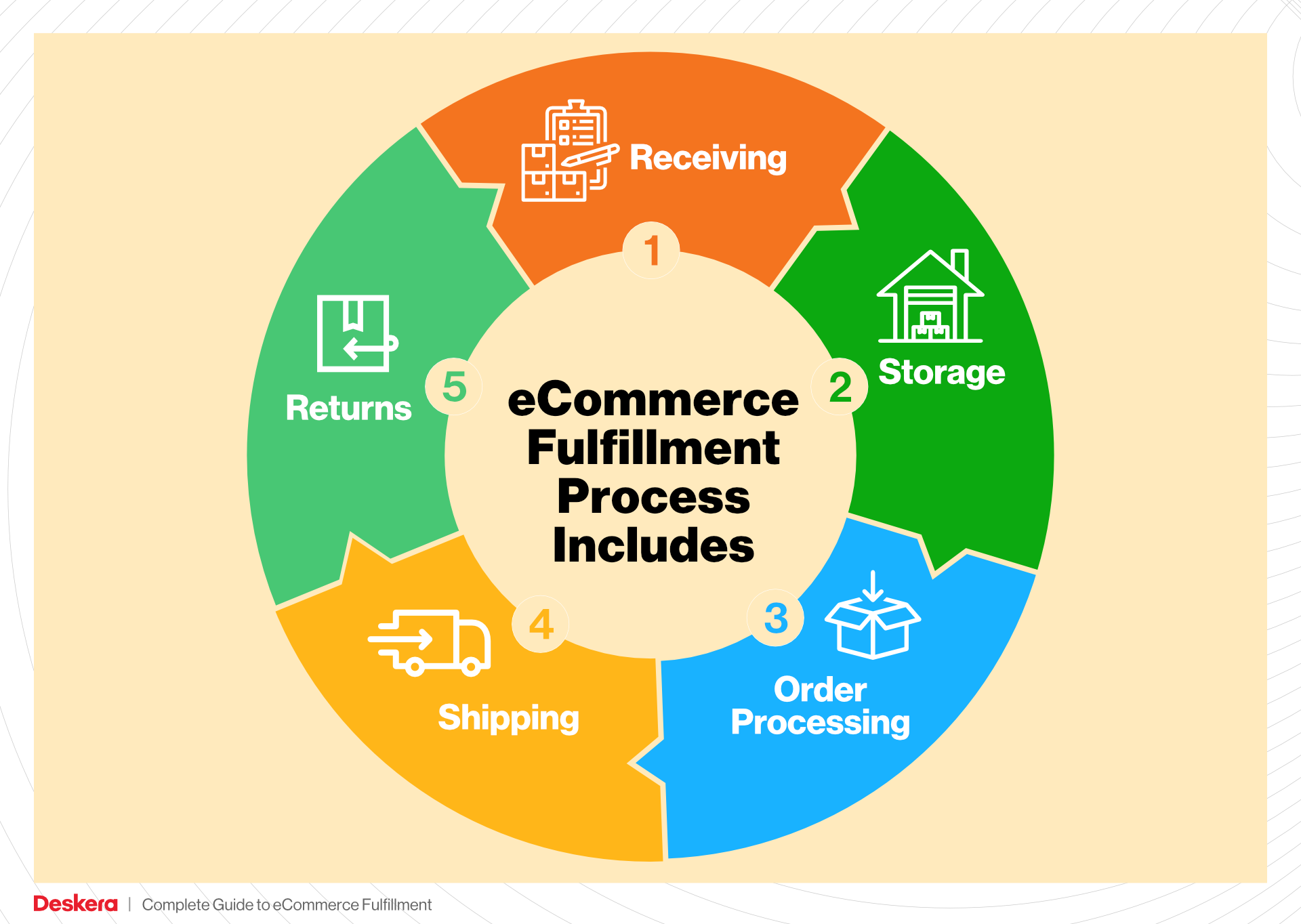
Key Term: FIFO (First In, First Out) – A method used in inventory management where the oldest stock (first in) is sold first (first out). This is particularly important for perishable goods but is also a best practice for managing inventory in general.
3. Order Picking
When a customer places an order, the next step is order picking. This involves retrieving the items from their storage locations based on a generated pick list, which details the items and their locations within the warehouse. Pickers use this list to collect the necessary products efficiently.
Importance: Accurate and efficient order picking is critical to ensure that customers receive the correct items. Delays or mistakes during this stage can lead to increased return rates, customer dissatisfaction, and higher operational costs.
Key Term: Pick List – A document or digital display that outlines the items to be retrieved for an order, including their locations within the warehouse. It serves as a roadmap for pickers to follow during the order fulfillment process.
4. Order Packing
After items are picked, they move to the packing station. Here, products are carefully packaged for shipment. This process may involve selecting appropriate packaging materials, adding branded elements (like packing slips or promotional materials), and ensuring that items are secured to prevent damage during transit.
Importance: Packing is not just about protecting the product; it also provides an opportunity to enhance the customer experience. A well-packed order can lead to positive impressions and repeat business. Additionally, optimizing packing can reduce shipping costs by minimizing package size and weight.
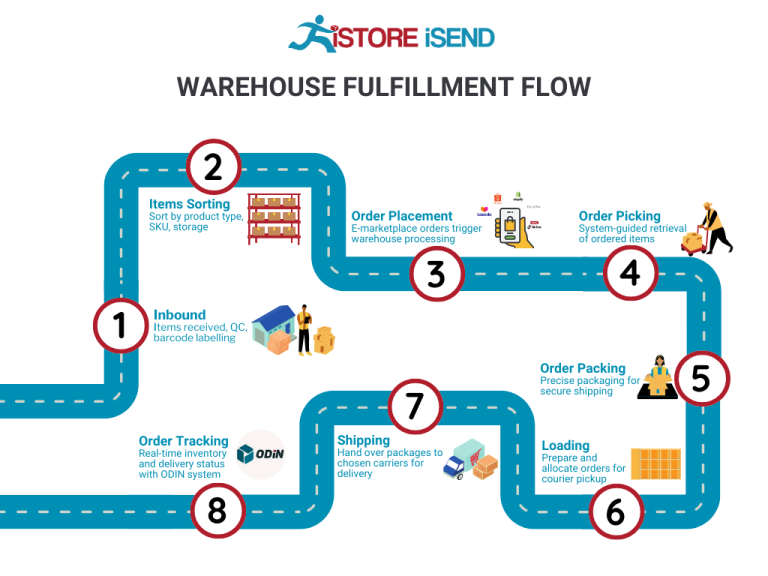
Key Term: Kitting – The process of assembling multiple items into a single package or kit. This is often used for promotional bundles or subscription boxes and requires careful coordination to ensure that all components are included.
5. Shipping & Delivery
The final step in the order fulfillment process is shipping and delivery. Once packed, orders are labeled and prepared for shipment. This involves choosing the appropriate shipping method based on factors such as cost, speed, and destination. Fulfillment companies often partner with multiple carriers to provide flexible shipping options.
Importance: Timely and accurate shipping is essential for customer satisfaction. In today’s e-commerce environment, consumers expect fast delivery times, and delays can lead to lost sales and damaged reputations. Therefore, monitoring delivery performance is crucial for continuous improvement.
Key Term: Last Mile Delivery – Refers to the final step of the delivery process, where the package is transported from a distribution hub to the final delivery destination. This stage is often the most complex and expensive part of the shipping process, making it a key focus for optimizing fulfillment operations.
By understanding and optimizing each of these steps, e-commerce businesses can enhance their fulfillment processes, reduce costs, and ultimately improve customer satisfaction.
Comparing Fulfillment Models: In-House vs. 3PL vs. Dropshipping
Fulfillment Model Comparison
| Model | Who Handles Inventory | Best For (Business Stage) | Key Advantage | Key Disadvantage |
|---|---|---|---|---|
| In-House Fulfillment | The business itself | Start-ups to established businesses | Full control over operations and branding | High overhead costs and resource demands |
| Third-Party Logistics (3PL) | A third-party provider | Growing businesses and scale-ups | Cost-effective and scalable solutions | Less control over fulfillment processes |
| Dropshipping | Supplier/vendor | Start-ups and low-capital businesses | Low overhead and risk | Lower profit margins and potential delays |
In-House Fulfillment
In-house fulfillment involves managing the entire logistics process internally, from inventory storage to order processing, packing, and shipping. This model is most suitable for businesses that are either in the start-up phase or have established operations and want to maintain complete control over their fulfillment processes. The key advantage of in-house fulfillment is the ability to oversee every aspect of the operation, ensuring quality and consistency in customer experience. Businesses can tailor the packaging and shipping processes to align with their brand identity, creating a unique unboxing experience for customers. However, the disadvantages include significant overhead costs related to warehousing, staffing, and technology investments. Moreover, as order volumes increase, the complexities of managing logistics can stretch resources thin, potentially leading to inefficiencies and errors.
Third-Party Logistics (3PL)
Third-party logistics (3PL) providers handle the logistics and supply chain needs of businesses by managing inventory, warehousing, order fulfillment, and shipping. This model is particularly advantageous for growing businesses that are looking to scale operations without the burden of managing logistics in-house. One of the most significant benefits of using a 3PL is cost-effectiveness; businesses can leverage the provider’s established infrastructure, which often includes advanced technology and a network of fulfillment centers. This not only reduces shipping times but also cuts costs, as 3PLs can negotiate better shipping rates due to their volume. However, the main downside is the loss of control over the fulfillment process. Businesses may find it challenging to ensure that their brand standards are maintained, especially in terms of packaging and customer service. Additionally, relying on a third party can introduce risks such as service disruptions or mismanagement of inventory.
Dropshipping
Dropshipping is a fulfillment model where the retailer does not keep goods in stock but instead partners with suppliers who fulfill orders directly to customers. This model is ideal for start-ups or businesses with limited capital, as it eliminates the need for inventory investment and reduces overhead costs associated with warehousing and logistics. The primary advantage of dropshipping is the low risk; businesses only pay for products after they have been sold, minimizing the financial burden. Furthermore, it allows for a wide variety of products to be offered without the need for storage space. However, dropshipping comes with its own set of challenges. Profit margins are typically lower compared to other models, as suppliers may charge higher prices for the convenience of handling fulfillment. Additionally, businesses may face issues with inventory availability, shipping delays, and quality control, which can ultimately impact customer satisfaction.
In summary, choosing the right fulfillment model is a critical decision that depends on various factors, including business stage, resources, and long-term goals. In-house fulfillment provides maximum control but comes with higher costs, while 3PLs offer scalability at a lower cost but may dilute brand experience. Dropshipping serves as a low-risk entry point for new businesses but can lead to lower profit margins and potential fulfillment challenges. Each model has its unique advantages and disadvantages, and business owners must carefully evaluate their specific needs and capabilities to determine the best approach for their e-commerce operations.
A Deep Dive into Amazon FBA: Pros, Cons, and Who It’s For
Understanding Fulfillment by Amazon (FBA)
Fulfillment by Amazon (FBA) is a service offered by Amazon that enables e-commerce sellers to store their products in Amazon’s fulfillment centers. Amazon takes care of storage, packaging, and shipping, allowing sellers to leverage Amazon’s robust logistics network. This service can be a game-changer for e-commerce businesses looking to scale rapidly, as it provides access to Amazon’s vast customer base and Prime members.
How FBA Works
-
Setup: Sellers first need to create an Amazon seller account and register for the FBA program. Once registered, they can list their products on Amazon.
-
Inventory Shipment: Sellers send their inventory to Amazon’s fulfillment centers. Amazon provides guidelines on how to package and label items to ensure they are ready for storage and shipment.
-
Storage: Once the inventory arrives at the fulfillment center, Amazon takes over the responsibility of storing the products. Sellers can track their inventory levels through their Amazon seller account.
-
Order Fulfillment: When a customer places an order for a product fulfilled by FBA, Amazon handles the entire fulfillment process. This includes picking, packing, and shipping the order directly to the customer.
-
Customer Service and Returns: Amazon manages customer service inquiries and returns for FBA orders, which can significantly reduce the operational burden on sellers.
Pros of Using FBA
1. Prime Eligibility
One of the most significant advantages of using FBA is the eligibility for Amazon Prime. Products fulfilled by Amazon are marked as Prime eligible, which can lead to increased visibility and sales. Prime members tend to spend more, and offering Prime shipping can give sellers a competitive edge.
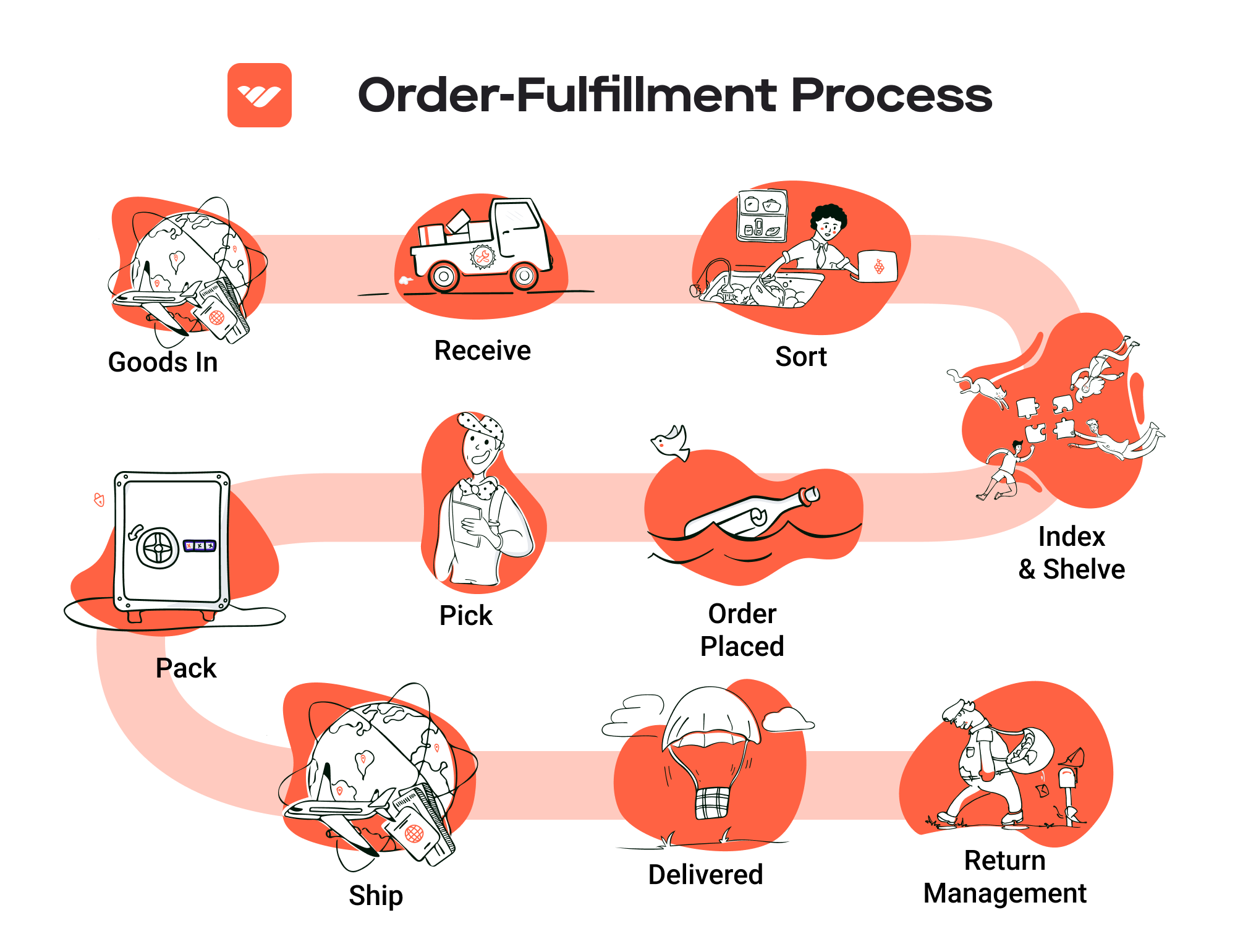
2. Customer Trust
Amazon is a trusted platform, and customers often feel more secure purchasing products that are fulfilled by Amazon. The assurance of reliable shipping and customer service can enhance the seller’s credibility and lead to higher conversion rates.
3. Multi-Channel Fulfillment
FBA isn’t limited to Amazon sales. Sellers can also use FBA to fulfill orders from other sales channels, including their own websites or other marketplaces. This flexibility allows businesses to centralize their logistics and streamline operations.
4. Scalable Operations
FBA allows sellers to scale their operations without worrying about the logistics of storage and shipping. As sales increase, sellers can send more inventory to Amazon, enabling them to focus on marketing and product development rather than fulfillment logistics.
5. Simplified Logistics
By outsourcing fulfillment to Amazon, sellers can simplify their logistics processes. Amazon handles storage, packaging, shipping, and returns, freeing up time and resources for sellers to focus on other aspects of their business.
Cons of Using FBA
1. High Fees
While FBA provides many advantages, it comes with a cost. Sellers must pay various fees, including storage fees (which can increase during peak seasons) and fulfillment fees for each order processed. These costs can add up, particularly for smaller businesses or those with lower profit margins.
2. Strict Inventory Rules
Amazon has strict inventory management rules that sellers must adhere to. Failing to comply can result in penalties or removal of inventory. Additionally, sellers must monitor their stock levels closely to avoid long-term storage fees or stockouts.
3. Commingling Risks
FBA uses a commingling system, where products from multiple sellers are stored together. This can lead to issues if a seller’s inventory is mixed with that of another seller, resulting in potential counterfeit or misbranded products being sent to customers. This risk can damage a seller’s reputation and lead to customer dissatisfaction.
4. Limited Control Over Fulfillment
While outsourcing fulfillment can be beneficial, it also means that sellers have limited control over the fulfillment process. Any issues with shipping or customer service are handled by Amazon, which can lead to frustration for sellers who prefer to manage these aspects directly.
5. Dependency on Amazon
Using FBA can create a dependency on Amazon’s platform. Sellers may find themselves at the mercy of Amazon’s policies, fee structures, and algorithm changes, which can impact their business significantly.
Who is FBA Best For?
Fulfillment by Amazon is best suited for e-commerce businesses that:
-
Have a Solid Product Line: Businesses with a diverse range of products can benefit from the scalability and logistics efficiencies offered by FBA.
-
Target Amazon’s Customer Base: Companies looking to tap into Amazon’s vast customer base and benefit from Prime eligibility will find FBA appealing.
-
Desire to Focus on Growth: Sellers who prefer to focus on marketing, product development, and customer engagement rather than the complexities of logistics will find FBA to be a valuable partner.
-
Are Prepared for Fees: Businesses that can absorb the costs associated with FBA and have a clear strategy for managing their inventory and fulfillment fees will be better positioned to succeed.
-
Seek Multi-Channel Opportunities: Sellers who plan to sell across multiple platforms will appreciate the flexibility of using FBA for order fulfillment beyond Amazon.
In conclusion, while FBA offers numerous advantages for e-commerce businesses looking to scale, it is crucial for sellers to weigh these benefits against the potential downsides. Understanding the intricacies of FBA can help businesses make informed decisions about whether it aligns with their growth strategies and operational capabilities.
Core Services Offered by Fulfillment Centers
Inventory Management & Warehousing
Effective inventory management and warehousing are foundational elements of e-commerce fulfillment. Fulfillment centers offer businesses a centralized location to store their products securely. This service typically includes real-time tracking of inventory levels, automated replenishment alerts, and the ability to easily monitor stock across multiple locations.
The benefits of robust inventory management are significant. For e-commerce businesses, it ensures that stock levels are optimized to meet customer demand without incurring excess holding costs. With advanced inventory systems, businesses can avoid stockouts that lead to lost sales, while also minimizing overstock situations that can tie up capital. Moreover, fulfillment centers often provide scalable warehousing solutions, allowing businesses to adjust their storage needs based on sales fluctuations, seasonal trends, or expansion into new markets.
Pick and Pack Services
Pick and pack services are a critical aspect of order fulfillment, ensuring that products are accurately selected and prepared for shipment. In this process, fulfillment center staff pick the ordered items from the warehouse shelves and pack them according to specific guidelines—often tailored to enhance the customer experience.
The primary advantage of efficient pick and pack services is speed and accuracy. Fulfillment centers typically employ trained staff and advanced technology to maintain high accuracy rates, often exceeding 99%. This precision minimizes the likelihood of shipping errors, which can lead to customer dissatisfaction and increased return rates. Additionally, quick turnaround times in order processing can enhance customer satisfaction and loyalty. By outsourcing pick and pack functions, e-commerce businesses can focus on core operations, such as marketing and product development, while ensuring that their customers receive their orders promptly.
Kitting and Assembly
Kitting and assembly services involve the bundling of different products into a single package, or assembling multiple components into a finished product before shipping. This service is particularly beneficial for businesses that sell products that often go together—such as gift sets, subscription boxes, or products requiring assembly.
The benefits of kitting and assembly are multifaceted. First, it streamlines the order fulfillment process by reducing the time spent on packaging individual items. This efficiency can lead to faster shipping times and lower labor costs. Second, kitting allows businesses to create unique product offerings that can enhance their brand appeal. For instance, offering a curated selection of products as a single purchase can increase average order values and improve customer satisfaction. Lastly, fulfillment centers that offer kitting services can help businesses manage seasonal promotions or special events more effectively by preparing bundled offers in advance.
Returns Management (Reverse Logistics)
Returns management, or reverse logistics, is an essential service provided by fulfillment centers that handles the return process for products that customers send back. This process includes receiving returned items, inspecting them for damage, restocking inventory, and managing exchanges or refunds.
The importance of efficient returns management cannot be overstated. For e-commerce businesses, a seamless return process is a significant factor in customer satisfaction and retention. Customers are more likely to purchase from a retailer that offers a hassle-free return policy, which can lead to increased sales. Additionally, effective returns management helps businesses analyze return data to identify trends—such as frequent reasons for returns—which can inform product development and quality control efforts.
Moreover, a well-managed returns process can help minimize losses associated with returns. By quickly restocking items and managing inventory levels, fulfillment centers can reduce the impact of returns on overall profitability. They can also offer options for refurbishing or reselling returned products, creating additional revenue streams for e-commerce businesses.
Conclusion
In summary, fulfillment centers provide a comprehensive suite of services that are crucial for the success of e-commerce businesses. From inventory management and warehousing to pick and pack services, kitting and assembly, and returns management, these core services enable businesses to operate efficiently, enhance customer satisfaction, and scale effectively. By leveraging the expertise and resources of fulfillment centers, e-commerce businesses can focus on growth and innovation while ensuring that their logistics and supply chain operations are handled with care and precision.
How to Choose a Fulfillment Partner: A 6-Point Checklist
Location & Warehouse Network
Why It Matters:
The geographical location of your fulfillment partner and the distribution of their warehouses can significantly impact shipping costs and delivery times. A partner with a robust network of warehouses can facilitate faster shipping to your customer base, which is crucial for maintaining customer satisfaction and loyalty.
Questions to Ask:
– How many fulfillment centers do you operate, and where are they located?
– Can you distribute my inventory across multiple locations to optimize shipping times and costs?
– What is your average shipping time for orders from your warehouses to key markets?
Technology & Integrations
Why It Matters:
In today’s digital landscape, the ability to seamlessly integrate with your existing e-commerce platforms, inventory management systems, and customer relationship management tools is essential. A technologically advanced fulfillment partner can automate processes, reduce human error, and provide real-time tracking information for both you and your customers.
Questions to Ask:
– What technology do you use for order management, inventory tracking, and reporting?
– Can your system integrate with my e-commerce platform (e.g., Shopify, WooCommerce, Amazon)?
– Do you offer real-time inventory updates and order tracking for my customers?
Specializations (e.g., cold storage, oversized items)
Why It Matters:
If your products have specific storage or handling requirements, it’s crucial to choose a fulfillment partner that specializes in those areas. Whether you’re dealing with perishable goods, oversized items, or fragile products, the right partner will have the necessary facilities and expertise to handle your inventory safely and efficiently.
Questions to Ask:
– What types of products do you specialize in fulfilling?
– Do you have facilities for temperature-sensitive items or specialized equipment for oversized products?
– How do you handle unique packing or shipping requirements for my products?
Scalability & Capacity
Why It Matters:
As your business grows, your fulfillment needs will evolve. A partner that can scale with you will save you the hassle of switching providers down the line. Understanding their capacity to handle increased order volumes and their flexibility in adapting to your growth is essential for long-term success.
Questions to Ask:
– What is your current capacity for order fulfillment, and how do you manage peak seasons?
– How quickly can you accommodate an increase in order volume?
– What processes do you have in place to ensure that quality and efficiency are maintained as order volumes rise?
Pricing and Contracts
Why It Matters:
Transparent pricing structures and contract terms are vital for budgeting and financial planning. Understanding all potential costs—including storage fees, shipping rates, and any additional services—will help you avoid unexpected expenses. Moreover, flexible contract terms can provide you with the freedom to adapt your partnership as your business evolves.
Questions to Ask:
– What is your pricing model (e.g., per order, per item, monthly fees)?
– Are there any hidden fees, such as setup costs or long-term contracts?
– Can you provide a breakdown of all costs associated with your services?
Customer Support & Reviews
Why It Matters:
Excellent customer support can make a significant difference in your fulfillment experience. A responsive and knowledgeable support team can help resolve issues quickly and efficiently, minimizing disruptions to your operations. Furthermore, researching reviews and testimonials from current and former clients can provide insight into the partner’s reliability and service quality.
Questions to Ask:
– What kind of support do you offer (e.g., dedicated account manager, 24/7 support)?
– How do you handle issues or complaints that arise during the fulfillment process?
– Can you provide references or case studies from clients in my industry?
Conclusion
Selecting the right fulfillment partner is a critical step in scaling your e-commerce business. By considering these six key points—Location & Warehouse Network, Technology & Integrations, Specializations, Scalability & Capacity, Pricing and Contracts, and Customer Support & Reviews—you can make an informed decision that aligns with your operational needs and growth objectives. Remember to ask detailed questions and evaluate each potential partner against these criteria to ensure a successful partnership.
Understanding Fulfillment Pricing: A Breakdown of Common Fees
Initial Setup Fees
When partnering with a fulfillment company, businesses often encounter initial setup fees. These are one-time costs associated with onboarding your products into the fulfillment center’s system. Setup fees can vary significantly based on the complexity of your inventory and the specific requirements of your business. Factors such as the number of SKUs, the need for custom packaging, and integration with your e-commerce platform can all influence these costs.
Typically, fulfillment companies charge anywhere from a few hundred to several thousand dollars for initial setup. To manage these costs, it’s advisable to ask potential fulfillment partners for a detailed breakdown of what the setup entails. Some companies may waive these fees as part of promotional offers or for businesses committing to long-term contracts.
Receiving Fees
Receiving fees are charged for the process of accepting and processing your inventory when it arrives at the fulfillment center. This can include unloading, inspecting, and entering the inventory into the warehouse management system (WMS).
These fees are usually calculated based on the volume of inventory received, often expressed as a per-pallet or per-item rate. For example, a fulfillment center may charge a flat fee for each pallet received or a tiered rate depending on the total number of units. Understanding how these fees are structured can help you plan your inventory shipments more effectively and potentially negotiate better rates based on your volume.
Storage Fees (per pallet/bin)
Storage fees are recurring costs associated with keeping your inventory in the fulfillment center. These fees can be calculated on a per-pallet or per-bin basis, depending on how the fulfillment center organizes its storage.
Storage fees typically vary depending on the location of the warehouse and the time of year. For instance, rates may increase during peak seasons when demand for storage space surges. It’s essential to clarify whether these fees are charged monthly or quarterly, and whether there are any minimum storage requirements. Some fulfillment providers also offer discounts for long-term storage commitments, which can be beneficial if your business has stable inventory levels.
Pick & Pack Fees (per item/order)
Pick and pack fees are charged for the labor involved in selecting items from inventory and packaging them for shipment. This fee can be structured as a per-item fee or a flat rate per order, depending on the fulfillment provider’s pricing model.
For example, a provider may charge $0.50 per item picked and packed, or a flat fee of $2.00 per order, regardless of the number of items. Understanding this fee is crucial, especially for businesses with a wide variety of products or those that frequently run promotions with multiple items per order. Some fulfillment centers may also offer volume discounts, which can significantly reduce costs for high-order volumes.
Shipping Fees
Shipping fees are one of the most variable components of fulfillment pricing and can significantly impact your overall costs. These fees depend on several factors, including the shipping method (standard, expedited, or international), the weight and dimensions of the package, and the destination.
Fulfillment companies often have partnerships with major carriers, allowing them to provide discounted rates. These discounts can vary based on the volume of shipments you send through the fulfillment center. Some providers may also offer flat-rate shipping options for certain regions or products, which can simplify budgeting and forecasting. It’s essential to understand the shipping options available and how they align with your business’s needs and customer expectations.
Tips for Getting an Accurate Quote
To ensure you receive an accurate fulfillment quote, consider the following tips:
-
Be Transparent About Your Needs: Provide detailed information about your product types, order volumes, and shipping requirements. The more a fulfillment provider knows about your business, the more accurate their quote will be.
-
Request Itemized Pricing: Ask for a breakdown of all potential fees, including setup, receiving, storage, pick & pack, and shipping fees. This transparency will help you compare different providers effectively.
-
Evaluate Additional Services: Inquire about any additional services that may be beneficial for your business, such as kitting, returns management, or custom packaging. These can influence overall costs and should be factored into your decision-making process.
-
Negotiate Terms: Don’t hesitate to negotiate terms and fees, especially if you expect high order volumes or are planning a long-term partnership. Many fulfillment providers are open to customizing pricing based on your business needs.
-
Consider Long-Term Costs: Look beyond initial quotes and consider the long-term costs associated with each fulfillment provider. Factors such as scalability, service quality, and operational efficiency can significantly impact your total fulfillment expenses over time.
By carefully evaluating these aspects and engaging in open discussions with potential fulfillment partners, you can ensure that you make an informed decision that aligns with your e-commerce growth strategy.
Frequently Asked Questions (FAQs) about Fulfillment
1. What is a fulfillment company?
A fulfillment company is a third-party service provider that handles the storage, packaging, and shipping of products on behalf of e-commerce businesses. They manage the logistics of getting products from the warehouse to the customer, allowing businesses to focus on sales and marketing.
2. What is the difference between a warehouse and a fulfillment center?
While both warehouses and fulfillment centers store products, their functions differ. A warehouse primarily focuses on storage and inventory management, whereas a fulfillment center specializes in processing and shipping orders quickly. Fulfillment centers are equipped to handle picking, packing, and shipping, often with advanced technology to streamline these operations.
3. What is a 3PL?
A Third-Party Logistics (3PL) provider is a company that offers outsourced logistics services, including warehousing, fulfillment, and shipping. They allow businesses to scale their operations without the need to invest in their own infrastructure, often providing access to a broader range of shipping options and expertise.
4. How much do fulfillment services cost?
Fulfillment service costs vary widely based on several factors, including order volume, storage needs, and specific services required (such as kitting or returns management). Typically, costs can include a per-order fee, storage fees, and shipping costs. It’s essential to request quotes from multiple providers to compare and find the best fit for your budget.
5. How do I choose the right fulfillment company?
When choosing a fulfillment company, consider factors such as their location, shipping speed, technology integration, customer service, and pricing structure. Look for companies that align with your business needs, offer scalability, and have a proven track record of reliability and accuracy.
6. Can I integrate my e-commerce platform with a fulfillment service?
Yes, most fulfillment companies offer integration options with popular e-commerce platforms like Shopify, WooCommerce, and Amazon. This allows for seamless order processing and inventory management, making it easier to manage your operations from a single dashboard.
7. What are the benefits of using a fulfillment service?
Using a fulfillment service can lead to increased efficiency, reduced shipping costs, faster delivery times, and the ability to scale operations without significant upfront investment. They can also enhance customer satisfaction through improved order accuracy and management of returns.
8. How does inventory management work with fulfillment companies?
Fulfillment companies typically use advanced Warehouse Management Systems (WMS) to track inventory levels in real-time. This allows businesses to monitor stock levels, automate reordering processes, and manage inventory across multiple locations efficiently.
9. What is the typical onboarding process for a fulfillment service?
The onboarding process usually involves connecting your e-commerce platform, sending inventory to the fulfillment center, and setting up your product listings. Many companies provide support during this phase to ensure a smooth transition and integration.
10. What should I know about international shipping with fulfillment services?
When considering international shipping, it’s crucial to understand the fulfillment provider’s capabilities regarding customs, duties, and shipping regulations. Many fulfillment companies offer global shipping solutions and can help navigate the complexities of international logistics, ensuring timely delivery to customers worldwide.
Conclusion: Is Outsourcing Fulfillment the Right Move for Your Business?
Evaluating the Benefits of Outsourcing Fulfillment
Outsourcing your fulfillment operations can be a transformative decision for e-commerce businesses seeking to scale efficiently. By leveraging the capabilities of a third-party logistics (3PL) provider, you can unlock several key benefits that directly contribute to your growth.
First and foremost, outsourcing fulfillment saves you significant time. With a dedicated partner handling the complexities of picking, packing, and shipping, you can refocus your internal resources on core business activities like marketing, product development, and customer engagement. This shift allows for a more streamlined operation, ultimately enhancing your service quality and customer satisfaction.
Moreover, scalability is a critical advantage of using fulfillment services. As your business grows, so does the volume of orders and the complexity of logistics. A reliable fulfillment partner can adapt to your changing needs, enabling you to scale operations seamlessly. Whether you’re launching new products, entering new markets, or managing seasonal spikes in demand, a 3PL can provide the flexibility and resources necessary to keep pace with your ambitions.
Additionally, partnering with a fulfillment expert brings valuable industry knowledge and technology to the table. These providers often have established networks, sophisticated inventory management systems, and insights into best practices that can help reduce costs and improve efficiency. This expertise can be pivotal in navigating challenges like international shipping regulations or optimizing your supply chain.
However, it is essential to choose the right fulfillment partner. Conducting thorough research and due diligence will ensure that you align with a provider who understands your unique business model and can support your long-term goals.
Take Action Now
As a strategic next step, audit your current shipping process. Assess your fulfillment costs, delivery times, and customer satisfaction levels. Consider if a fulfillment partner could enhance your operations and position your business for growth. Remember, the right partner can make all the difference in your e-commerce journey.
Important Disclaimer
⚠️ Important Disclaimer
The information in this guide is for educational purposes. Fulfillment services, pricing, and platform features change frequently. Always conduct your own due diligence and consult with providers directly before making business decisions.
